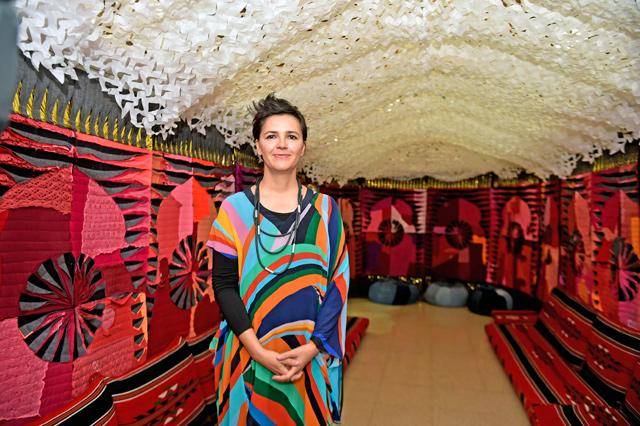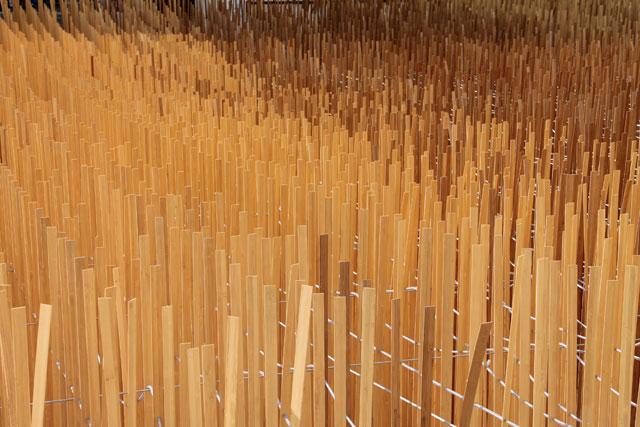You are here
Azraq refugees partner with designers to ‘invent solutions to their daily problems’
By Camille Dupire - Oct 10,2017 - Last updated at Oct 10,2017

The 'Design for a Nomadic World' exhibition showcases prototypes of inventions co-created by refugees of Azraq camp, students, engineers and artists (Photo by Camille Dupire)
AMMAN — “Needs create inventions,” stated Azra Aksamija, professor of art, culture and technology at MIT, who is one of the curators of the exhibition “Design for a Nomadic World” organised as part of the Amman Design Week (ADW) 2017.
Held at the German Jordan University (GJU) building of downtown Amman, "Design for a Nomadic World" explores how art, architecture and design can address the various needs of refugees, while also fostering a better cross-cultural understanding and social cohesion between migrant and host communities, according to a statement by the organisers.
“Our project consists of several projects working in parallel involving many parties including the youth at the Azraq refugee camp, students and engineers from the GJU, and academics at MIT,” Aksamija, who is also an artist, told The Jordan Times at the exhibition on Monday.
Beginning informally as the “book of problems”, the project sought to list and understand the various issues encountered by refugees in their daily lives at the camp.
“When we visited the camp, we realised that these people have amazing talents and have been creating astonishing inventions just to improve their daily lives,” Aksamija said.
Rasha Al Sharqawi, a GJU architecture student, noted: “For them, these are not inventions, they are just objects they created because they needed it.” She cited the example of Rawan Hussein, a 14-year-old Syrian who invented a washing machine out of two buckets to wash her family’s clothes.
After two months spent documenting the inventions found at the camp through more than 500 photographs, the team designed the “book of problems”, which mapped the issues encountered, the inventions created as solutions, and categorised them inside a “book of inventions”.
“Design should be used critically to tackle real issues,” Aksamija said, explaining that the title of the exhibition is a direct reference to Victor Papanek’s book “Design for the Real World” published in1971.
“His work showed that design has become too estranged with the ‘real needs’ of people, and should be more socially, politically aware of the environment,” the artist continued.
Translating design into projects that help answer the emotional, cultural and social needs of refugees was the primary aim of the exhibition, she explained, noting that it has been a constant exchange of expertise between all parties.
“As students and engineers, we work on a prototype that we send to the camp, and then they send it back to us with their modifications,” Sharqawi said, noting that it is a “back-and-forth process of co-creation”.
The end product of the exhibition, called the “Lightweaver”, is a collaborative piece that showcases the work of all people involved, said Aksamija, whose main research focuses on transcultural aesthetics, cultural mobility, and ways in which art and architecture can form a bridge between cultures.
Still under development, the Lightweaver is a playful kinetic lighting machine and an educational device developed in collaboration with the artists, calligraphists, engineers and inventors from the Azraq camp.
“The kids create the most amazing things with no resources. They have only cardboards but they have managed to create experimental devices that play with various senses and they keep coming up with new ideas,” Sharqawi said, noting that the project has also had a therapeutic impact for the refugees.
“Some of the refugees we met were very depressed, stricken with the lack of activity and the austerity of the shelters. But, throughout the project, we have seen them transform and regain hope and a sense of meaning,” the duo concluded.
The exhibition, which was curated by Zeid Madi and Melina Philippou, was held with the support of Mohammad Yaghan, professor at the GJU's School of Architecture and the Built Environment.
Related Articles
AMMAN — T-Serai, a textile art installation, which highlights humanitarian causes including refugees, climate change and textile overproduct
AMMAN — Saturday marked the third official day of the Amman Design Week (ADW), offering a wide selection of learning and cultural opportunit
AMMAN — Upon entering Amman Design Week’s (ADW) Zain cultural space at Al Hussein Cultural Centre, the visitor is struck by a free flowing i


















